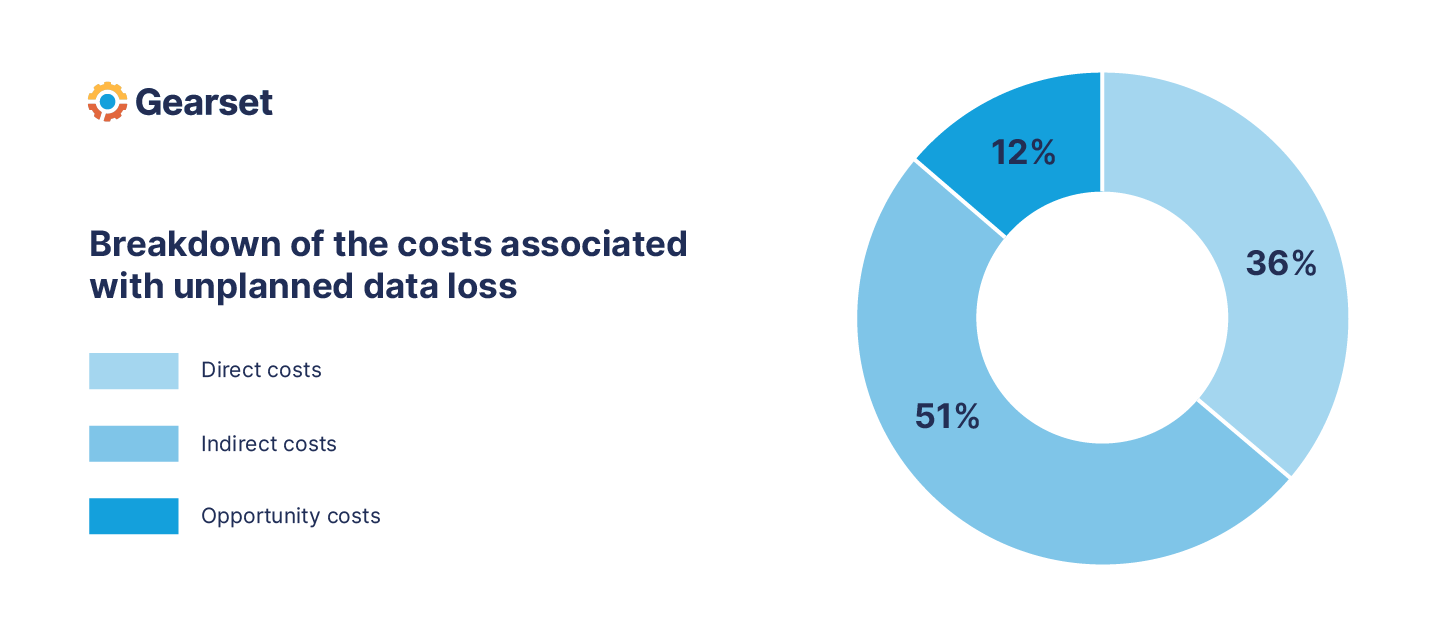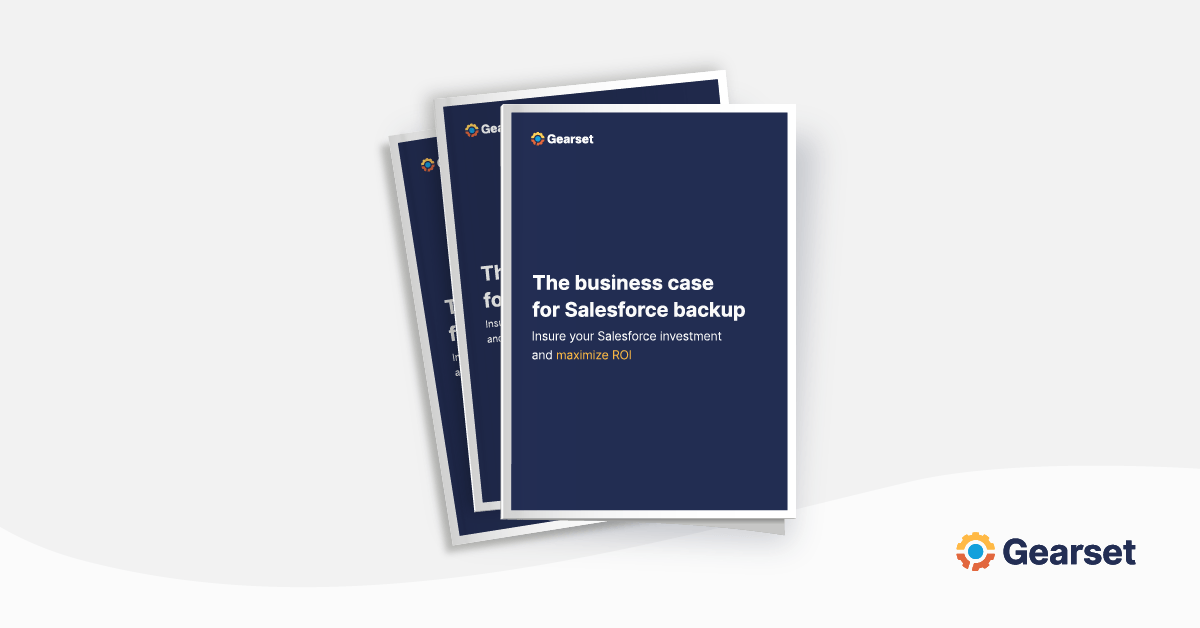Budgets are tight. Any requests for new digital overheads — hirings, software spend, or training — rightfully come under scrutiny from decision makers in technical areas and the wider business. As a result, it can be hard to win approval for Salesforce backup spend.
Building a business case for Salesforce backup is the only way to convince others that this investment is essential. Many teams only consider the risks and associated costs of Salesforce data loss — presenting a backup solution as mitigation for worst-case scenarios. But that’s only half the story. A successful case for backup should also demonstrate that there are clear benefits that go far beyond protecting you when problems arise.
Read on to learn how you can approach a cost-benefit analysis for Salesforce backup spend, and make a convincing case for the wider business.
Addressing common objections
Experienced Salesforce teams know that backup plays a critical role in your business’ integrity — safeguarding you against the risks of data loss, protecting your reputation, and winning customer trust. At a time when most businesses are looking to minimize risk, technical teams realize it’s reckless to overlook the possibility of Salesforce data loss or downtime.
However, it’s often hard to convince decision makers that Salesforce backup is necessary due to a couple of common concerns. Here’s how to address them:
New York, US
Agentforce World Tour New York
“Salesforce data is safer because it’s stored in the cloud!”
The belief that Salesforce doesn’t need backup because it’s cloud-based still lingers. To overcome this, you’ll need to reframe the understanding of cloud-based software.
Salesforce is stored in the cloud so that its users can access and manage it from any location, so long as they have an internet connection. This storage system is designed for ease of access, not for ease or reliability of data management. Ultimately, all data in the cloud is still hosted on physical servers somewhere, making Salesforce as vulnerable to data loss as any on-premises data hosting.
“We don’t need a backup solution because Salesforce has native tools for data recovery”
Salesforce provides a variety of native backup tools, but only their Backup and Restore solution can help you to restore in the event of data loss. Their other services — namely Data Recovery, Data Loader, Data Export — only enable you to access some Salesforce data in the form of a .CSV file. These native tools have critical flaws from both a technical and business perspective:
- While Salesforce’s Backup and Restore does allow you to restore from backups, you run the risk that any downtime to the Salesforce platform will also undermine this tool — leaving you unable to restore from backup.
- All other native backup tools rely on you to manually restore your Salesforce data from a .CSV file and offer no metadata backup.
- If you rely on Salesforce’s native Data Recovery Service, there’s no guarantee that all of your data can be recovered. There’s also, typically, a 6–8 week wait for Salesforce to send you your data, giving you a slow Recovery Time Objective. During this period, your Salesforce operations will be stalled, having knock-on effects across the business.
“We only need to worry about critical data loss”
Salesforce experts know that it isn’t enough to just back up against worst-case data loss. You have to consider minor losses and metadata too. Small-scale data loss can still be massively disruptive to your Salesforce org — undermining end-users processes, alongside wasting time while trying to identify and resolve the data loss — all of which adds up to a cost and disruption for the wider business. It’s critical to highlight that these seemingly minor data losses do mount up to a tangible business impact.
Similarly, it’s easy to overlook that metadata loss on the Salesforce platform should be taken as seriously as data loss. While your end-users’ work is continuously adding data to your org, developer and admin time is dedicated to creating the metadata that structures workflows, processes and data entry. So, losing your Salesforce metadata is throwing away a huge amount of Salesforce development time and potentially causing further data loss or disrupting end-users. You need both data and metadata backup.
You’ll need to address these fundamental concerns before you can convince decision makers to weigh up the costs and benefits of a backup solution.
Demonstrate the benefits of a backup solution
Even once decision makers have been convinced that data (and metadata!) loss on the Salesforce platform is a threat with real repercussions, it can be difficult to quantify the ROI of a backup solution if you’re mainly thinking in terms of backup as an insurance policy for disaster recovery. A business case for backup should cover both the costs of losses alongside the measurable ROI of backup.
Avoid the costs of data loss
Start by highlighting that there’s a clear financial benefit to avoiding the costs of Salesforce data and metadata loss. Because there are different scales of data and metadata loss, this cost is variable. However, you can still provide some firm pointers to the components and range of cost that can come from Salesforce data loss:
- Compliance breaches: This could be a direct cost from Salesforce data loss. With compliance fines as high as 10 million euros for a breach of GDPR, it’s clear that there can be high immediate costs to Salesforce data loss.
- Revenue loss: Your business could suffer the cost of redirecting resources to deal with disaster recovery after a data and metadata loss. This indirect cost is hugely variable depending on the scale of the loss.
- Reputation damage: The time invested in building your brand, customer trust and market positioning is jeopardized by Salesforce data loss. This, alongside the lost leads and conversions, are a type of opportunity cost that can arise.
You can assume that the overall cost of data and metadata loss will roughly be comprised of these three components, in this ratio:

The ROI of a backup solution
There are further benefits of a backup solution that go beyond avoiding the costs of Salesforce data and metadata loss.
Ease of auditing and compliance
A Salesforce backup solution enables you to fulfill compliance requirements and complete audits to prove it. This not only allows you to avoid the costs of breaches, but can help reduce compliance spend. There are further compliance benefits as you’ll increase trust from your customers with robust compliance certifications.
Promotion of agile development
Backup supports Salesforce teams in implementing agile development and DevOps practices. The knowledge that production is always safely stored in a backup and can be quickly restored promotes a frequent release cycle, allowing your business to begin reaping the benefits of agile development.
These benefits can help you to maximize the ROI of your existing investment in Salesforce, by streamlining both auditing and development on the platform.
Evaluate backup solution costs
The cost of a backup solution is largely dependent on the type that you opt for — a self-built backup tool or a third-party backup solution. There are lots of resources to help you evaluate the strengths and weaknesses of different backup options, but the costs associated are typically:
- The investment in building it: If you do choose to build your own backup tool, you’ll have to consider the cost of developer time to create this, subscription to your data host, and maintenance costs.
- Subscription fee: If you’re choosing a third-party backup solution, then you’ll pay either a monthly or annual subscription for use of their software and data hosting.
- Staff training: You’ll need to upskill your staff in backup best practices and the functionality of your backup solution. Some third-party providers minimize this cost by providing their own training.
- Potential future costs of scaling: With either a self-built or third-party backup solution, you’ll need to consider the potential cost of backup as your business scales. A self-built backup solution risks being overrun on either the data management or hosting side, which could require hiring new staff to manage this demand or additional payments to a hosting service. A third-party solution will likely have a tiered pricing structure, which gradually increases alongside the size of your Salesforce requirements.
You’ll want to bear the immediate and potential costs of a backup solution in mind when weighing up this side of your business case.
Gather the evidence
While the costs of a backup solution are concrete, the costs of data loss and benefits of backup are harder to quantify. As a result, it’s critical to gather industry research and data from your own Salesforce instance to help make your case. There are a few different data sources that you can look to:
- Industry information, from expert sources like the State of Salesforce DevOps report, can help you to contextualize. Pointing to headline stats, like the 67% of Salesforce teams who experienced at least one data or metadata loss last year, will help you to emphasize the necessity of backup.
- Concrete examples from your own Salesforce org can underpin your case. If you know that you’re already spending X amount of time on Salesforce development, which translates to Y amount of business spend, then it’ll be easier to make a case for spending Z on a backup solution that protects your Salesforce instance.
- The existing ROI of your Salesforce investment demonstrates that Salesforce is critical to business success, and will convince the wider business that it’s worth investing in protecting your Salesforce development work and data.
These sources can provide the evidence to underpin your business case for backup.
The business case for backup
While a good business case is always tailored to your own organization’s needs, spend and industry, it helps to contextualize it with data from your industry and expert opinion. That’s why we’ve created a free and ungated industry whitepaper that makes the business case for Salesforce backup. We’ve expanded on the technical and business benefits of backup, to help you make your case for Salesforce backup spend.
If you’re looking to measure the returns on your Salesforce backup solution, take a look at our useful webinar with practical advice on how to get started. And when you’re ready to start securing your Salesforce investment, start a 30-day free trial of Gearset’s backup and restore solution.



